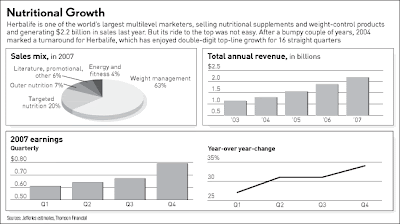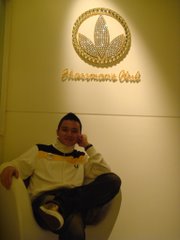Revenue climbed 19% to $578.1 million, driven by double-digit growth in several of Herbalife's top countries. It was the 16th straight quarter of double-digit growth.
2008年4月10日 星期四
Nutritional Supplement Maker Fattens As The World Slims Down
Monday March 24, 5:49 pm ET
The number of overweight and obese Americans is growing at an alarming rate and shows no sign of slowing down.
Last year, a nonprofit health organization conducted an obesity survey of all U.S. states comparing data from 2003-05 with statistics from 2004-06. The results were staggering.
The survey found obesity rates continued to rise in 31 of 50 states in 2006, according to Trust for America's Health. Not one state reported a decline.
According to the U.S. Centers for Disease Control and Prevention, two out of three Americans are overweight, and almost one in five are obese.
As obesity-related health problems increase, businesses are hunting for profitable weight-loss solutions. Many are finding the answer in Herbalife's (NYSE:HLF - News) "Formula 1" diet shake mix.
The Los Angeles-based Herbalife is a global, multilevel marketing company that sells weight-control, nutritional and personal care products. Judging by its most recent quarterly results, there is big upside for its weight-management products.
In the fourth quarter, earnings rose 34% to 79 cents a share ex items. Analysts polled by Thomson Financial had expected 73 cents.
Sales Increase
Revenue climbed 19% to $578.1 million, driven by double-digit growth in several of Herbalife's top countries. It was the 16th straight quarter of double-digit growth.
Revenue climbed 19% to $578.1 million, driven by double-digit growth in several of Herbalife's top countries. It was the 16th straight quarter of double-digit growth.
Full-year revenue increased 14% to $2.2 billion, from $1.89 billion in 2006. Weight-control products accounted for more than 60% of sales.
Nutritional supplements generated roughly 20% of top-line growth. Personal care and energy and fitness products also gained traction last year, rising 6.7% and 4.3%, respectively.
"This is a big, globally diverse multilevel seller that suffered some serious setbacks earlier this decade," said Douglas Lane, an analyst at Jefferies & Co. "But they have bounced back."
About 80% of the company's sales are derived from overseas, and results from last quarter were solid. Taiwan rose 19%, Russia was up 15%, Italy jumped 22% and China leapt 146%.
The U.S. is the company's largest single market and revenue grew 22% last quarter, based largely on the growth of its Latin markets, says Chief Executive Michael Johnson.
"Several factors are driving our growth, such as strong products, business opportunity and our growing brand, which is in front of more people than ever before," Johnson said.
Herbalife's global footprint and distribution base give it a competitive edge. It sells its products in 65 countries and has more than 1.7 million distributors, reflecting an annual increase of 8.6%.
Johnson says direct selling is a prime opportunity for anyone, whether seeking part-time or full-time income. "It's an industry with low startup costs," he said. "There are really no barriers to entry."
Like many direct-selling companies, Herbalife generates significant free cash flow with a modest capital requirement, Lane says. It also paid down more than $300 million in debt from 2004 to 2006.
Herbalife raised its earnings and revenue outlook for 2008. It estimates full-year sales growth of 9% to 11%, while pegging profit at $3.25 to $3.30 a share vs. a prior estimate of $3.17 to $3.23 a share.
The raised guidance signals that Herbalife has the ability to grow despite a sluggish economy and stiff competition from diet food companies such as Weight Watchers International (NYSE:WTW - News) and privately held Jenny Craig.
The outlook also shows that the company's move beyond multivitamins into products like meal replacements and appetite suppressants is working, Lane says.
Herbalife faced a difficult challenge after the untimely death of its charismatic founder Mark Hughes, who died in 2000 from a prescription-drug overdose at age 44.
It was one of a series of blows the company absorbed earlier this decade. But Herbalife bounced back after it was taken private in 2003 by private equity firms Whitney & Co. and Golden Gate Capital.
A Johnson-led management team was hired, and in December 2004 the company launched its second public offering in a span of less than 20 years.
Herbalife developed a five-point 18owth plan. The first part, distributor strategy, centered on three concepts: recruiting, retailing and retention. Thus far, it has been very successful.
Last year, more than 210,000 new sales leaders joined the company, an increase of 6.6%, while its retention rates were stable at 40%, except in Mexico, Johnson says.
Mexican Growth
Herbalife grew too quickly in Mexico without proper infrastructure, and the region overheated from hypergrowth, Lane says.
With poor distributors and supply-chain problems, the company was forced to retool in the region by launching its nutrition club plan.
"The clubs have fueled greater interaction between distributor and customer as well as a strong brand campaign," Johnson said.
While the clubs promote daily consumption of its products, they also create a comfortable social environment where people can gather and learn about nutrition.
With success in Mexico, the strategy was taken across the border to the U.S. as well as down to Brazil, which has also seen some retrenchment after several years of strong growth.
"We're optimistic about our future in Mexico, as it remains one of our top markets," Johnson said.
Herbalife increased education for its distributors in the regions and opened more sales centers to make its products more accessible to its sellers. After significant slowing in the early part of last year, the plan seems to be working.
The Mexico and Brazil markets had only modest sales declines in the fourth quarter of 1.4% and 2.6%, respectively, which was better than expected, Lane says.
Today, possessing a global footprint in fast-growing regions might be one of the best ways to offset a U.S. economic downturn. Employers in the U.S. have shed payrolls by 85,000 jobs so far in 2008.
"We're in an industry that works in good or bad economic times," Johnson said. "In this case, more people might explore working part time or full time to offset a job loss or for additional income."
The low barriers to entry in this business make it very attractive to those who may not have as much capital as they did a few years back.
"We're very optimistic about our future," Johnson said. "Last year was our best year yet, and we're just getting started."
太陽系外最小行星 距地球30光年之遙
(法新社馬德里九日電) 西班牙天文學家今天宣佈發現迄今已知太陽系外行星當中最小的行星,距離地球三十光年之遙。
天文學家藉由新式科技,偵測到這顆編號「GJ436T」的行星。西班牙科學研究所CSIC的李巴斯表示,這項新科技「讓我們在不到十年的時間,發現第一顆在質量與運行軌道方面都和地球相似的行星。」
李巴斯領導的研究團隊,GJ436T與其他行星都圍繞在獅子座內一顆恆星,他們發現GJ436T對其他行星的引力作用,才偵測到GJ436T。
李巴斯公佈這項發現時指出,GJ436T的質量為地球的五倍,是太陽系外約三百個已知行星當中最小一個。
他表示,GJ436T這顆新行星與繞行恆星間的距離遠短於地球與太陽間的距離,因此不宜人類居住。
能夠讓生命存在的行星,必須具備與地球類似的質量、大氣層、表面必須存在液態水,與恆星之間的距離,也必須與地球和太陽相仿。
研究團隊初步估計顯示,GJ436T自轉一周所需的時間為地球的四點二天,公轉一周則需五點二天。
(法新社馬德里九日電) 西班牙天文學家今天宣佈發現迄今已知太陽系外行星當中最小的行星,距離地球三十光年之遙。
天文學家藉由新式科技,偵測到這顆編號「GJ436T」的行星。西班牙科學研究所CSIC的李巴斯表示,這項新科技「讓我們在不到十年的時間,發現第一顆在質量與運行軌道方面都和地球相似的行星。」
李巴斯領導的研究團隊,GJ436T與其他行星都圍繞在獅子座內一顆恆星,他們發現GJ436T對其他行星的引力作用,才偵測到GJ436T。
李巴斯公佈這項發現時指出,GJ436T的質量為地球的五倍,是太陽系外約三百個已知行星當中最小一個。
他表示,GJ436T這顆新行星與繞行恆星間的距離遠短於地球與太陽間的距離,因此不宜人類居住。
能夠讓生命存在的行星,必須具備與地球類似的質量、大氣層、表面必須存在液態水,與恆星之間的距離,也必須與地球和太陽相仿。
研究團隊初步估計顯示,GJ436T自轉一周所需的時間為地球的四點二天,公轉一周則需五點二天。
Posted by
JIM'S LIFE X HERBALIFE = SUPER WONDERFUL LIFE
at
4/10/2008 10:19:00 下午
0
comments
![]()
鈴聲響就抓狂 小心患手機恐懼症
一名業務員只要聽到鈴聲或者音樂,就會以為是手機鈴聲響,全身極度不舒服,求助精神科醫師後發現,原來是因為公司規定「手機絕對不准漏接」,長期累積壓力,導致「手機恐懼症」!醫師表示如果再不求助,不只鈴聲,可能連任何和手機有關的圖案和產品,都會導致胸悶、暈眩症狀只會越來越嚴重。
手機響起,第一個反應卻是緊張、全身顫抖,越來越多人得了手機恐懼症!精神科醫師曾碰過經驗10多年的業務,隨身帶2支手機,全年不敢關機,因為公司規定,不准漏接客戶電話。
國軍北投醫院精神科主任李光輝:「(初期症狀)他會感到不安,他會感到煩躁,會感到全身緊張,會焦慮。」
因為手機而煩躁的情緒持續緊繃,業務員的症狀越來越嚴重,甚至害怕到連別人的手機響,或者只是聽到音樂,都會胸悶、暈眩。李光輝:「可能他在工作場合做件事,被老闆在手機內責罵,或他在手機裡跟女朋友分手,這些傳達訊息的現象,都造成他當時情緒的連結。」
原來手機一旦變成壓力來源,可能導致自律神經失調,丟了手機卻只能治標不治本,醫師建議,壓力來時,把空氣用力吸到肚子裡再慢慢吐出來,放鬆心情,無法緩解症狀,就可能真的需要求助醫師。
Posted by
JIM'S LIFE X HERBALIFE = SUPER WONDERFUL LIFE
at
4/10/2008 10:06:00 下午
0
comments
![]()
訂閱:
文章 (Atom)



